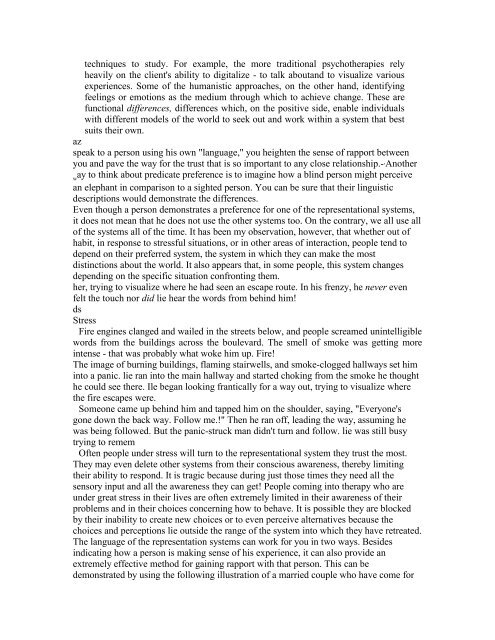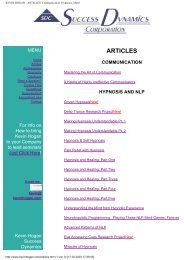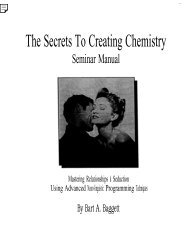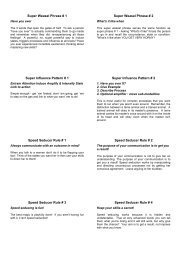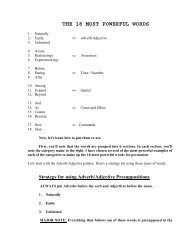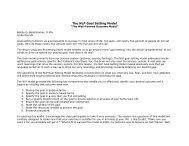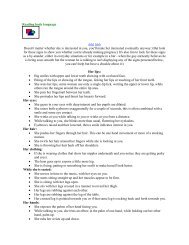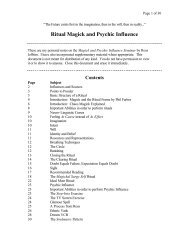A Pragmatic Guide To Communication & Change.pdf - NLP Info Centre
A Pragmatic Guide To Communication & Change.pdf - NLP Info Centre
A Pragmatic Guide To Communication & Change.pdf - NLP Info Centre
- No tags were found...
Create successful ePaper yourself
Turn your PDF publications into a flip-book with our unique Google optimized e-Paper software.
techniques to study. For example, the more traditional psychotherapies rely<br />
heavily on the client's ability to digitalize - to talk aboutand to visualize various<br />
experiences. Some of the humanistic approaches, on the other hand, identifying<br />
feelings or emotions as the medium through which to achieve change. These are<br />
functional differences, differences which, on the positive side, enable individuals<br />
with different models of the world to seek out and work within a system that best<br />
suits their own.<br />
az<br />
speak to a person using his own "language," you heighten the sense of rapport between<br />
you and pave the way for the trust that is so important to any close relationship.- , Another<br />
way to think about predicate preference is to imagine how a blind person might perceive<br />
an elephant in comparison to a sighted person. You can be sure that their linguistic<br />
descriptions would demonstrate the differences.<br />
Even though a person demonstrates a preference for one of the representational systems,<br />
it does not mean that he does not use the other systems too. On the contrary, we all use all<br />
of the systems all of the time. It has been my observation, however, that whether out of<br />
habit, in response to stressful situations, or in other areas of interaction, people tend to<br />
depend on their preferred system, the system in which they can make the most<br />
distinctions about the world. It also appears that, in some people, this system changes<br />
depending on the specific situation confronting them.<br />
her, trying to visualize where he had seen an escape route. In his frenzy, he never even<br />
felt the touch nor did lie hear the words from behind him!<br />
ds<br />
Stress<br />
Fire engines clanged and wailed in the streets below, and people screamed unintelligible<br />
words from the buildings across the boulevard. The smell of smoke was getting more<br />
intense - that was probably what woke him up. Fire!<br />
The image of burning buildings, flaming stairwells, and smoke-clogged hallways set him<br />
into a panic. lie ran into the main hallway and started choking from the smoke he thought<br />
he could see there. Ile began looking frantically for a way out, trying to visualize where<br />
the fire escapes were.<br />
Someone came up behind him and tapped him on the shoulder, saying, "Everyone's<br />
gone down the back way. Follow me.!" Then he ran off, leading the way, assuming he<br />
was being followed. But the panic-struck man didn't turn and follow. lie was still busy<br />
trying to remem<br />
Often people under stress will turn to the representational system they trust the most.<br />
They may even delete other systems from their conscious awareness, thereby limiting<br />
their ability to respond. It is tragic because during just those times they need all the<br />
sensory input and all the awareness they can get! People coming into therapy who are<br />
under great stress in their lives are often extremely limited in their awareness of their<br />
problems and in their choices concerning how to behave. It is possible they are blocked<br />
by their inability to create new choices or to even perceive alternatives because the<br />
choices and perceptions lie outside the range of the system into which they have retreated.<br />
The language of the representation systems can work for you in two ways. Besides<br />
indicating how a person is making sense of his experience, it can also provide an<br />
extremely effective method for gaining rapport with that person. This can be<br />
demonstrated by using the following illustration of a married couple who have come for


